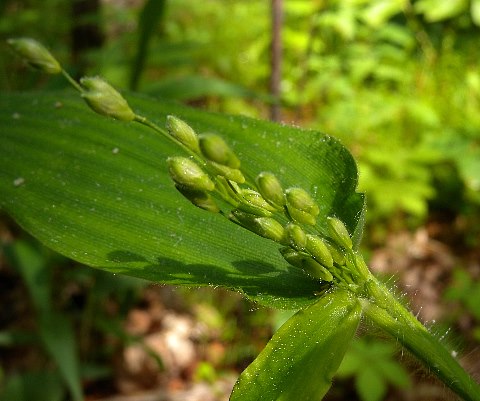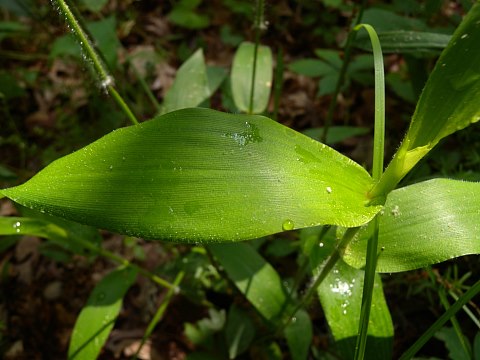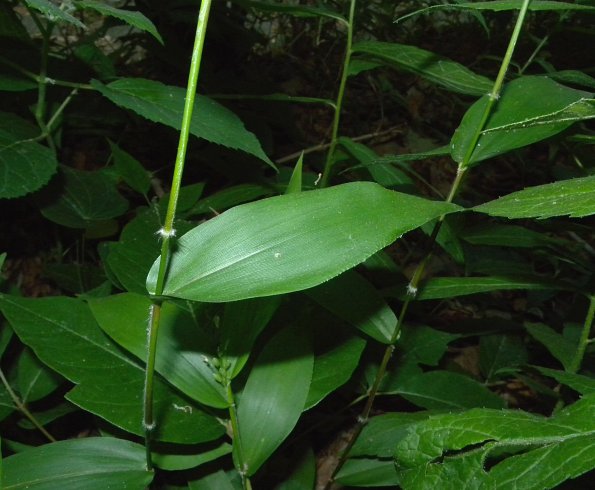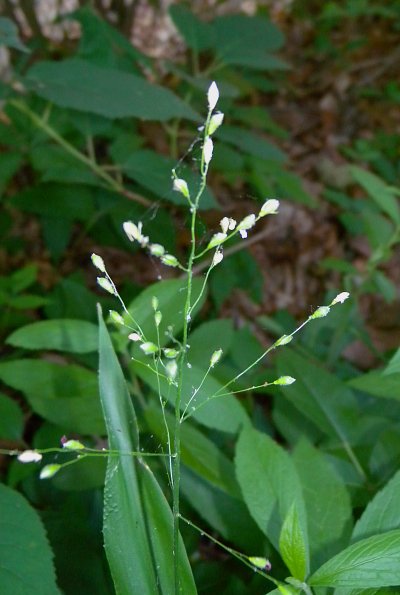Description: This perennial grass is 1–2½' tall, forming loose tufts of leafy culms that are more or less erect. The culms are usually branched, often at mid-length; they are light green, terete, and either glabrous or sparsely short-pubescent. Each culm typically has 4-6 alternate leaves. The leaf blades are up to 5" long and 1¼" (30 mm.) across; they are medium green, elliptic or narrowly lanceolate, flat, and widely spreading. The bases of these blades clasp the culms. For the typical variety of this grass, the blades are hairless on their upper surfaces and hairless to sparsely short-pubescent on their lower surfaces. For var. molle, the blades are sparsely short-pubescent on their upper surfaces and velvety-pubescent on their lower surfaces. The leaf sheaths are hairless to sparsely short-pubescent for the typical variety, while for var. molle they are quite hairy. The nodes of both varieties have long white hairs that are downward-pointing (retrorse). The ciliate ligules at the junctions of sheaths and blades are up to 1 mm. long. The culm (and any lateral branches) terminates in a panicle of spikelets up to 5" long and a little less across (when fully exerted from its sheath). The slender branches of the panicle are ascending, slightly wiry, and either glabrous or scabrous. The outer branches terminate in solitary spikelets that are 4–4.5 mm. long, about 2 mm. across, ellipsoid-obovoid in shape, and finely pubescent.

Each spikelet consists of a pair of glumes, a sterile lemma, and a fertile lemma enclosing a perfect floret. The first glume is about one-third the length of the spikelet, ovate in shape, and 3-veined; the second glume is the same length as the spikelet, elliptic-obovate in shape, and 7-veined. The outer sterile lemma has the same characteristics as the second glume, while the inner fertile lemma is the same length as the spikelet and largely hidden from view. The blooming period occurs from late spring into the summer, lasting 1-2 weeks for a colony of plants. The florets are cross-pollinated by the wind. Afterwards, these florets are replaced by grains that are about 3 mm. long, broadly ellipsoid in shape, and slightly flattened. The root system is fibrous and rhizomatous. Loose tufts of clonal plants often develop from the rhizomes. Later in the summer and early autumn, these flowering culms die down and they are replaced by rosettes of low branching culms with smaller leaves. These autumnal culms also produce panicles of spikelets, but these panicles remain inserted within the sheaths or they are only partially exserted.

Cultivation:
The
preference is dappled sunlight to medium shade, moist to dry-mesic
conditions, and rocky soil containing some loam and decaying organic
matter.
Range & Habitat:
Bosc's Panic Grass is native to Illinois. The typical variety of this
grass is occasional in southern Illinois, uncommon in west-central and
north-central Illinois, and absent from the NE and east-central
sections of the state (see Distribution
Map). In contrast, var.
molle
has been found only in southern Illinois. Habitats include upland rocky
woodlands, savannas, rocky wooded slopes, slopes of wooded
ravines, banks of streams in rocky canyons, limestone glades, and
thinly wooded bluffs. This grass can be found where either sandstone or
limestone lies close to the ground surface. In wooded areas, it
benefits from occasional wildfires.

Faunal Associations: Insects that feed on Bosc's Panic Grass and other panic grasses (Dichanthelium spp., Panicum spp.) include the leaf beetle Chalepus bicolor, the caterpillars of Poanes hobomok (Hobomok Skipper) and other skippers, leaf-mining larvae of the moths Elachista radiantella and Elachista solitaria, the stilt bug Jalysus spinosus, the stink bug Mormidea lugens, the plant bugs Collaria meilleuri and Collaria oculata, Colopha ulmicola (Elm Cockscomb Aphid) and other aphids, the leafhoppers Polyamia herbida and Polyamia rossi, Arphia sulphurea (Sulphur-winged Grasshopper), and caterpillars of the butterfly, Lethe anthedon (Northern Pearly Eye); see the Insect Table for more information. The seeds of panic grasses are eaten by such upland gamebirds and songbirds as the Wild Turkey, Bobwhite, and various sparrows. The White-Tailed Deer and Cottontail Rabbit browse on the foliage occasionally.

Photographic
Location:
An upland rocky woodland at the Portland Arch in west-central Indiana,
and a streambank in a rocky canyon in southern Illinois.
Comments:
This species has one of the widest leaf blades of any panic grass in
Illinois (exceeding 1" across). As a result, it has a very distinctive
appearance. Another species with wide leaf blades is Dichanthelium
latifolium (Broad-leaved Panic Grass); it has a similar
appearance and prefers similar habitats. While Bosc's Panic Grass has
nodes with long downward-pointing hairs, the nodes of Broad-leaved
Panic Grass are hairless or nearly so. The downy variety of Bosc's
Panic Grass, Dichanthelium boscii molle, is similar
in appearance to Dichanthelium ravenelii (Ravenel's
Panic Grass), as they both have nodes with downward-pointing hairs,
hairy sheaths, and leaf blades with velvety undersides. However, the
leaf blades of Ravenel's Panic Grass are more narrow (¾" across or
less). An older scientific name of Bosc's Panic Grass is Panicum
boscii. Another common name for this species is Large-fruited
Panic Grass.